Gender Male Spouse(s) Celeste First appearance Histoire de Babar, 1931 | Species Elephant Occupation King TV show Babar | |
 | ||
Similar Barbapapa, Lord Rataxes, Noddy, Marsupilami, Peter Rabbit | ||
Babar the Elephant is a fictional character who first appeared in 1931 in the French children's book Histoire de Babar by Jean de Brunhoff.
Contents
- Story synopsis
- History
- Influence and legacy
- Criticism and controversy
- Books
- Films and television
- References
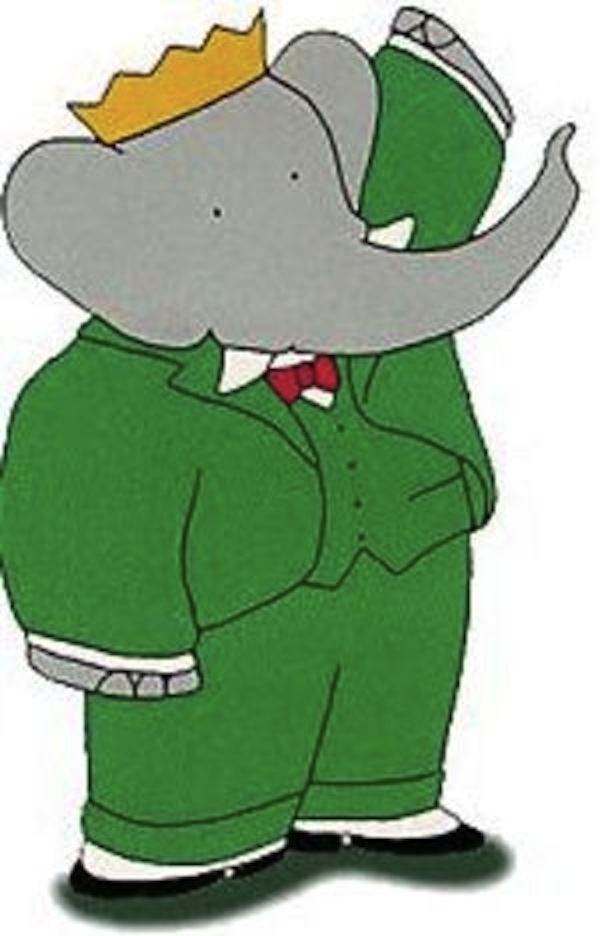
The book is based on a tale that Brunhoff's wife, Cecile, had invented for their children. It tells of a young elephant Babar whose mother is killed by a hunter. Babar escapes, and in the process leaves the jungle, visits a big city, and returns to bring the benefits of civilization to his fellow elephants. Just as he returns to his community of elephants, their king dies from eating a bad mushroom. Because of his travels and civilization, Babar is appointed king of the elephant kingdom. He marries his cousin, and they subsequently have children and teach them valuable lessons. The book series show the successful civilization of someone by the Western World.

Story synopsis
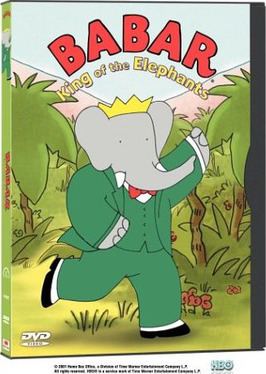
After Babar's mother is shot by a hunter, he flees the jungle and finds his way to an unspecified big city with no particular characteristics. He is befriended by The Old Lady, who buys him clothes and hires him a tutor. Babar's cousins Celeste and Arthur find him in the big city and help him return to the Elephant realm. Following the death of the King of the Elephants, who had eaten a poisonous mushroom (fly agaric?), a council of elephants approach Babar, saying that as he has "lived among men and learned much", he would be suitable to become the new King. Babar is crowned King of the Elephants and marries his second cousin Celeste.
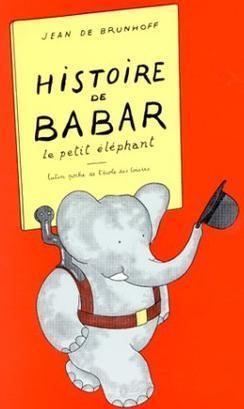
In Jean de Brunhoff's second Babar book, The Travels of Babar, when the married couple leave by balloon on their honeymoon:
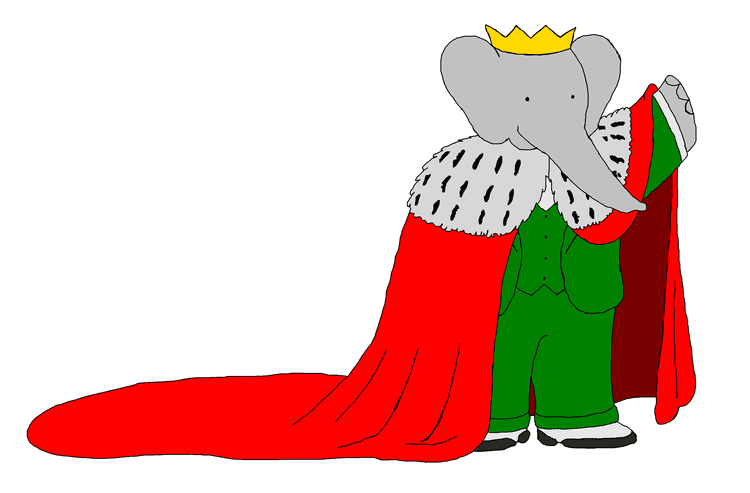
"...stormy winds down the balloon on an island, and yet again will the royal couple escape by whale, be marooned on an even smaller island and be rescued by a passing ocean liner only to be turned over to an animal trainer and put to work in a circus. And when they escape and return home, what awaits them but war with the rhinoceroses."
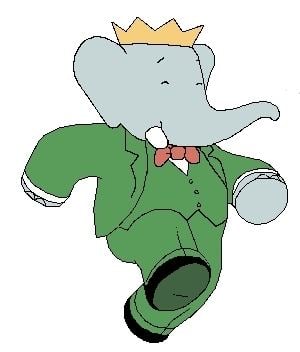
Babar wins the war by having the elephants paint monster faces on their backsides, which cause the frightened rhinoceroses to run away. After the victory celebrations, the book ends with Babar, Celeste and The Old Lady sitting together and discussing how Babar can rule wisely and make all the elephants happy.
In the third book, Babar the King, he founds the city of Celesteville.
Among Babar's other associates in the various incarnations of the series are the monkey Zephir, the old elephant counsellor Cornelius (also later Pompadour who was created for the Babar TV series), Babar's cousin Arthur, and Babar's children, Pom, Flora, and Alexander. Later, a second daughter, Isabelle, was introduced. The Old Lady comes to live in the Kingdom as an honoured guest. Despite the presence of these counsellors, Babar's rule seems to be totally independent of any elected body, and completely autocratic; however, his leadership style seems to be one that works for the overall benefit of his elephant subjects—a form of benevolent dictator.
Besides his Westernizing policies, Babar engages in warfare with the warlike rhinoceroses of a hostile bordering nation, who are led by Lord Rataxes. Much later, in Babar and the Adventures of Badou, Pom grew up and became the father of Prince Babar II (known as Badou) Babar's grandson.
History
In 1931, Jean de Brunhoff introduced Babar in Histoire de Babar, and Babar enjoyed immediate success. In 1933, A.A. Milne introduced an English-language version, The Story of Babar, in Britain and the United States.
Before his death in 1937, Jean de Brunhoff published six more stories. His son Laurent de Brunhoff, also a writer and illustrator, carried on the series from 1946, beginning with Babar et Le Coquin d'Arthur.
An animated TV series Babar was produced in Canada by Nelvana Limited and Clifford Ross Company, originally running from 3 January 1989 to 5 June 1991, with 65 episodes. An additional 13 episodes aired in 2000. The character has also appeared in a number of films. The first two of Jean de Brunhoff's Babar books have inspired two major concert works: L'Histoire de Babar, le petit éléphant (The Story of Babar, the Little Elephant) by Francis Poulenc in 1940; and The Travels of Babar (Le Voyage de Babar) by Raphael Mostel in 1994.
Influence and legacy
Babar, who likes to wear a bright green suit, introduces a very French form of Western civilization to the elephants, and they soon dress in Western attire. The attention to stylish clothing perhaps reflects the fact that the original publisher of the books was Editions du Jardin des Modes, owned by Condé-Nast. The Babar books were the first Condé-Nast publications not specifically about fashion.
Author Maurice Sendak described the innovations of Jean de Brunhoff:
"Like an extravagant piece of poetry, the interplay between few words and many pictures, commonly called the picture book, is a difficult, exquisite, and most easily collapsible form that few have mastered....Jean de Brunhoff was a master of this form. Between 1931 and 1937 he completed a body of work that forever changed the face of the illustrated book."
The series has over 100 licensees worldwide, and the "Babar" brand has a multi-generational following. There are 12 Babar stores in Japan. A global cultural phenomenon, whose fans span generations, Babar stands alongside Mickey Mouse as one of the most recognized children's characters in the world. There are now over 30,000 Babar publications in over 17 languages, and over 8 million books have been sold. Laurent de Brunhoff's Babar's Yoga for Elephants is a top seller in the U.S. with over 100,000 copies sold to date. The Babar series of books are recommended reading on former First Lady Laura Bush's national reading initiative list. All 78 episodes of the TV series are broadcast in 30 languages in over 150 countries, making Babar one of the largest distributed animation shows in history. Babar has been a perennial favorite for years at the White House Easter Egg Roll.
Since 2001, the Babar franchise has been owned by Corus Entertainment's Nelvana in conjunction with the artist, Clifford Ross.
Babar made a nameless appearance in The New Traveller's Almanac (part of The League of Extraordinary Gentlemen series). Babar and his elephants escort Mina Murray and Allan Quartermain through the African jungle. Mina considers them "civilized and gentle", but Allan denies that their leader is really wearing a crown.
Criticism and controversy
Some writers, notably Herbert R. Kohl and Vivian Paley, have argued that, although superficially delightful, the stories can be seen as a justification for colonialism. Others argue that the French civilization described in the early books had already been destroyed by World War I and the books were originally an exercise in nostalgia for pre-1914 France. Ariel Dorfman's The Empire's Old Clothes is another highly critical view, in which he concludes, "In imagining the independence of the land of the elephants, Jean de Brunhoff anticipates, more than a decade before history forced Europe to put it into practice, the theory of neocolonialism." Adam Gopnik has a different point of view. In Freeing the Elephants he writes that it "is not an unconscious expression of the French colonial imagination; it is a self-conscious comedy about the French colonial imagination and its close relation to the French domestic imagination. The gist ... is explicit and intelligent: the lure of the city, of civilization, of style and order and bourgeois living is real, for elephants as for humans." He concludes that the satisfaction derived from Babar is based on the knowledge that "while it is a very good thing to be an elephant, still, the life of an elephant is dangerous, wild, and painful. It is therefore a safer thing to be an elephant in a house near a park."
Babar's Travels was removed from the shelves by library staff in East Sussex for what was perceived as stereotypes of Africans.
Books
Jean de Brunhoff wrote and illustrated seven Babar books; the series was continued by his son, Laurent de Brunhoff.
Jean de Brunhoff's Babar books, and the titles of the English translations, were:
Laurent de Brunhoff's books (selected list):
English translations of the original Babar books are routinely republished in the UK and in the USA, individually and in collections.
Other English-language titles about Babar include the following:
